The recipe I will introduce today is Braised Hairtail, which is great to make and eat at home. Among the recipes available on the internet, this is the most basic and simple, yet the taste is definitely guaranteed! If you prepare the hairtail and a few easily accessible ingredients along with the sauce, anyone can easily follow this recipe. So, let’s find out what this recipe is all about!
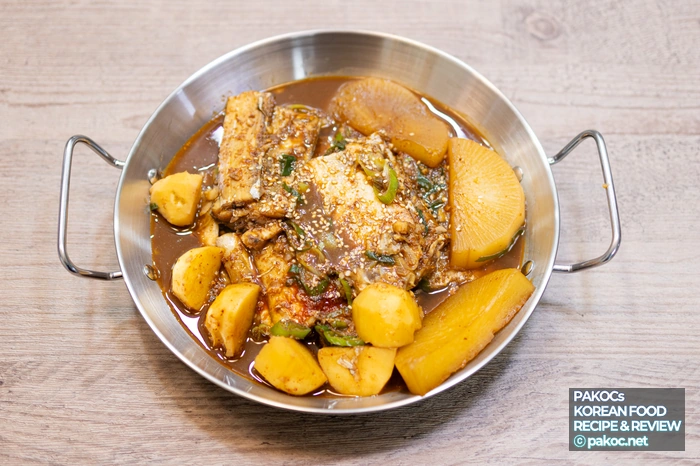
ⓒ
Copyright PAKOC https://pakoc.netIngredient Description
First, if you want to enjoy hairtail conveniently at home, I recommend purchasing pre-cleaned hairtail from the supermarket. Generally, supermarkets sell them in 400~500g packages, which will be perfect for the recipe! If you are not eating this alone, it will serve about 3~4 people for a family meal. I eat it alone, so 2 servings are enough for me, haha.
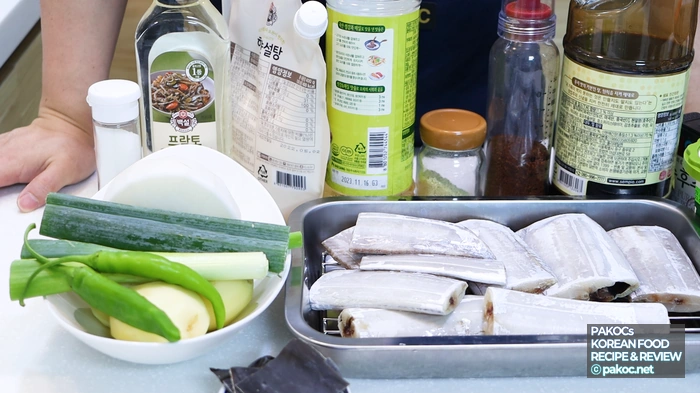
ⓒ
Copyright PAKOC https://pakoc.net[Braised Hairtail Recipe for 400~500g of Hairtail]
- 6~8 pieces of hairtail (400~500g)
- 3 sheets of kelp
- 300g radish, 2~3 potatoes, 1 green onion
- 500ml water
- 6 tablespoons soy sauce, 2 tablespoons red pepper powder
- 1 tablespoon minced garlic, 0.5 tablespoon ginger powder
- 2 tablespoons cooking wine, 1 tablespoon sugar, 1 tablespoon oligosaccharide
- 1 teaspoon pepper, 2~3 Cheongyang peppers
- 2 pinches of MSG, 1 tablespoon cooking water
- (Optional) rice water, soju, roasted sesame seeds, 1 tablespoon gochujang
Prepare an appropriate amount of radish, and it’s okay to use less if needed. Prepare other ingredients according to your personal preference!
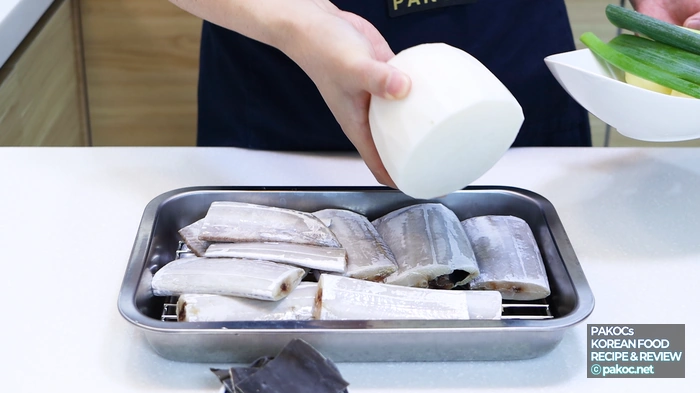
ⓒ
Copyright PAKOC https://pakoc.net
ⓒ
Copyright PAKOC https://pakoc.netIf there are some scales left on the hairtail, gently scrape them off with scissors and wash! Fill with an appropriate amount of water, pour 1~2 cups of soju, soak for a while, and then wash. Rice water is said to be the best, but if it’s hard to get suddenly, soju is enough. Personally, I think if you wash the processed fish well once, it doesn’t smell fishy, but it’s all about the feeling!

ⓒ
Copyright PAKOC https://pakoc.netRecipe Summary
- Soak the hairtail in rice water or water diluted with 2 cups of soju for about 20 minutes to remove the fishy smell.
- Slice the radish to a thickness of about 0.5cm and prepare enough to cover the bottom of the pot.
- Slice 2~3 potatoes to a thickness of about 0.5cm and soak in cold water to remove the starch.
- Diagonally slice 1 green onion and 2~3 Cheongyang peppers to an appropriate size.
- In a suitably low pot, add 500ml of water, the prepared radish, and 3 sheets of kelp, then bring to a boil. Once the water boils, remove the kelp and turn off the heat.
- While the water is boiling, mix 6 tablespoons of soy sauce, 2 tablespoons of red pepper powder, 1 tablespoon of minced garlic, 0.5 tablespoon of ginger powder, 2 tablespoons of cooking wine, 1 tablespoon of sugar, 1 tablespoon of oligosaccharide, 1 teaspoon of pepper, 2 pinches of MSG, and 1 tablespoon of cooking water to make the sauce. You can also mix 1 tablespoon of gochujang in advance.
- Place the potatoes and hairtail on top of the radish, pour the sauce over them, cover, and simmer. If you want a thicker sauce, add 1 tablespoon of gochujang in the middle.
- When the broth is reduced by about 50% and has a slightly thick texture, place the prepared green onions and Cheongyang peppers on top and bring to a boil. Occasionally ladle the broth over the top.
- Finish by sprinkling roasted sesame seeds or other toppings to taste.
👨🍳I prepared pre-cleaned hairtail from the supermarket. The purchased hairtail only needs to have the scales removed under running water (gently scrape with a knife) and the remaining innards cleaned.
👩🍳While cleaning the hairtail, remove the fins with scissors and make a slight cut at both ends to make it easier to remove the bones later.
👩🍳For removing the fishy smell from hairtail, rice water is highly recommended, but if not available, soju is also fine.
👨🍳Adding half an onion along with green onions and Cheongyang peppers can give a slightly sweet taste.
🥗 Ingredient preparation time: 40~50 minutes (including hairtail cleaning time)
🍳 Cooking time: 30 minutes
Preparing Ingredients
Assuming the hairtail is already prepared, let’s prepare the ingredients. Slice the radish to about 0.5cm thickness, enough to cover the bottom of the pot. Although this is a dish that is thoroughly cooked, the texture can vary according to personal preference, so prepare it to a thickness that suits your taste.
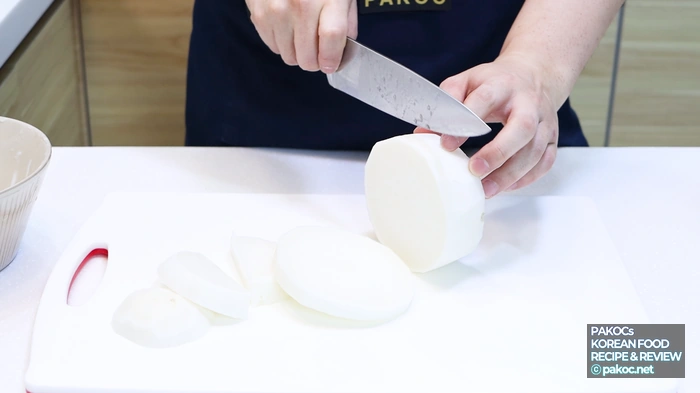
ⓒ
Copyright PAKOC https://pakoc.netSlice 2~3 potatoes to a thickness of about 0.5cm, but since the starch can make the broth too thick later, it’s good to soak them in cold water to remove the starch.
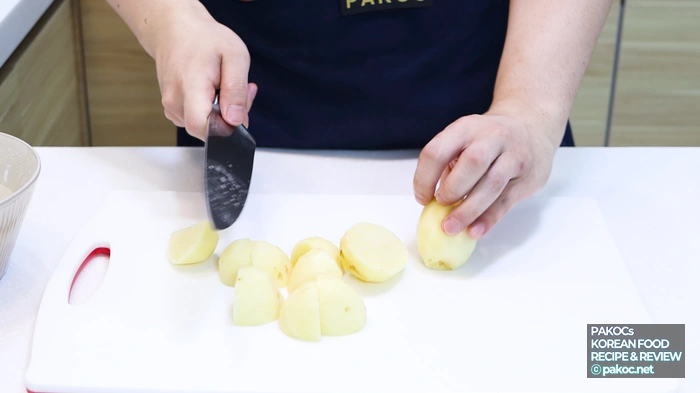
ⓒ
Copyright PAKOC https://pakoc.net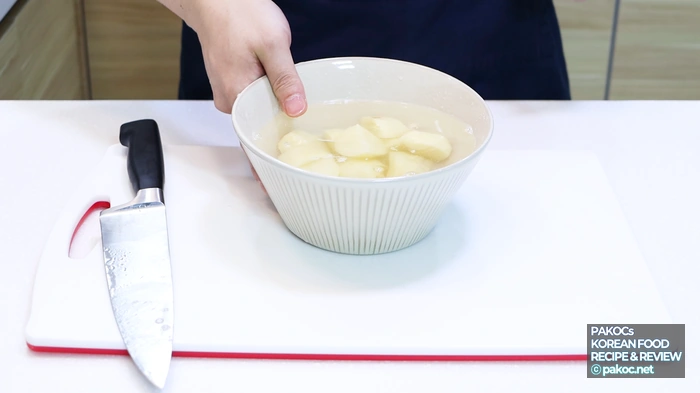
ⓒ
Copyright PAKOC https://pakoc.netDiagonally slice 1 green onion and 2~3 Cheongyang peppers to an appropriate size. However, these two are more like toppings, so they are not essential! Still, they are nice to have, and if not, they are missed green ingredients, so I personally recommend preparing at least one of them.
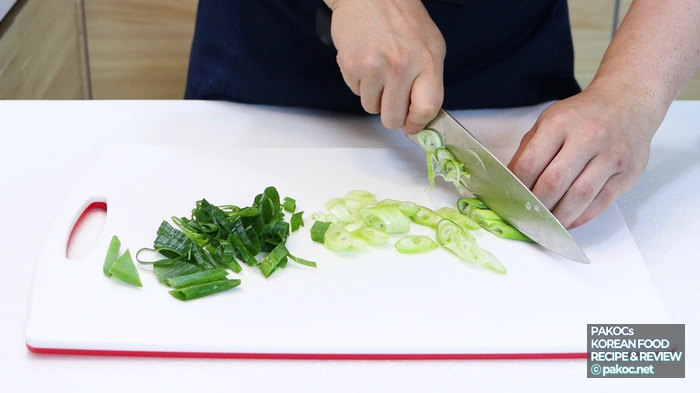
ⓒ
Copyright PAKOC https://pakoc.net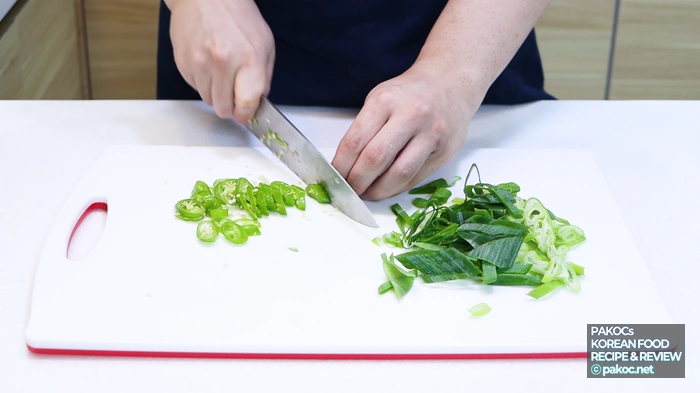
ⓒ
Copyright PAKOC https://pakoc.netUsually, at this point, you can pre-boil the radish, but since I am introducing the recipe, I will start with the sauce ingredients. Mix 6 tablespoons of soy sauce, 2 tablespoons of red pepper powder, 1 tablespoon of minced garlic, 0.5 tablespoon of ginger powder, 2 tablespoons of cooking wine, 1 tablespoon of sugar, 1 tablespoon of oligosaccharide, 1 teaspoon of pepper, 2 pinches of MSG, and 1 tablespoon of cooking water (yeondoo) to make the sauce. You can add 1 tablespoon of gochujang in advance, but I will add it later while cooking to adjust the seasoning.
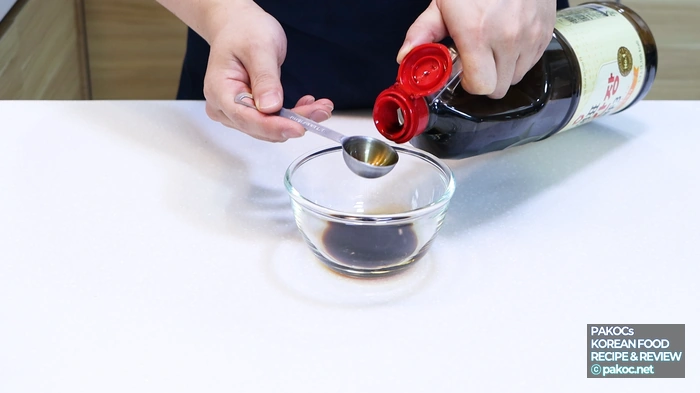
ⓒ
Copyright PAKOC https://pakoc.net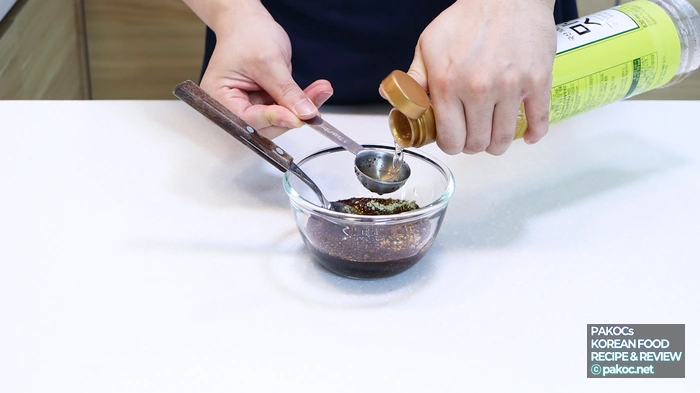
ⓒ
Copyright PAKOC https://pakoc.netInstead of oligosaccharide, you can add corn syrup to add a bit of gloss and sweetness. Mix the ingredients well and prepare by dipping a spoon deeply.
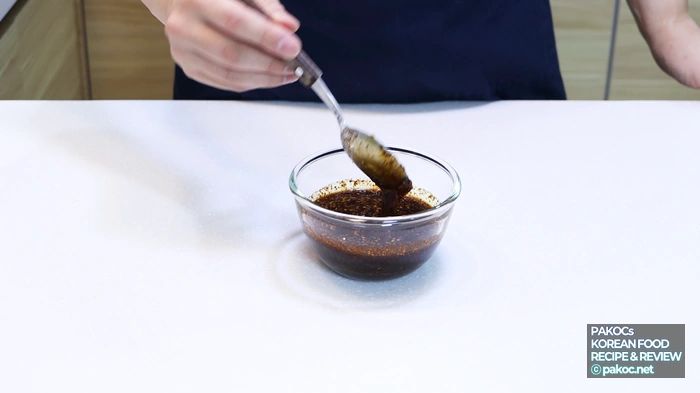
ⓒ
Copyright PAKOC https://pakoc.netNow that the hairtail, vegetables, and seasoning ingredients are all prepared, let’s start cooking. This recipe is about 70% preparation, and the rest is just adding the ingredients and boiling, so let’s get started right away.

ⓒ
Copyright PAKOC https://pakoc.netCooking
First, prepare a low pot suitable for braising. Lay the radish well on the bottom, add 500ml of water, and 3 sheets of kelp, then bring to a boil!

ⓒ
Copyright PAKOC https://pakoc.net
ⓒ
Copyright PAKOC https://pakoc.netOnce the water starts boiling, remove the kelp and you can slightly reduce the heat. Lowering to low heat is also fine! Place the hairtail on top of the radish first, then add the potatoes sparsely. Pour the sauce evenly, cover, and simmer over medium heat!

ⓒ
Copyright PAKOC https://pakoc.net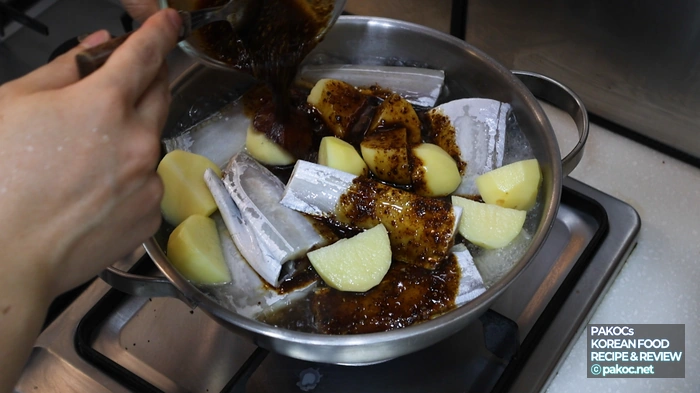
ⓒ
Copyright PAKOC https://pakoc.netWhen the broth is reduced by about 40~50% and becomes slightly thick, ladle the broth over the top while cooking. It’s good if the radish or potatoes feel soft when poked with chopsticks.
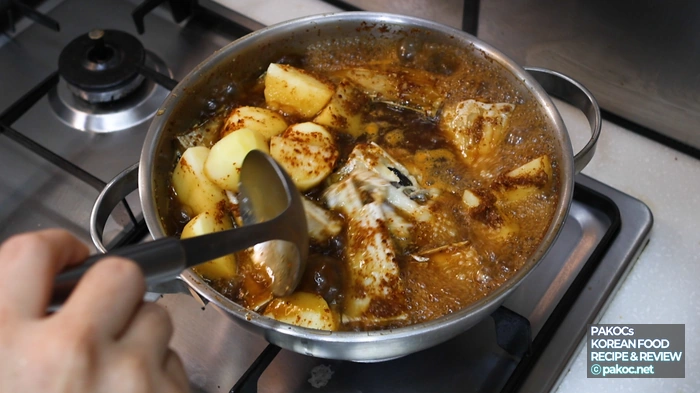
ⓒ
Copyright PAKOC https://pakoc.netCheck the seasoning once, and if you want a thicker and spicier sauce in the middle, add about 1 tablespoon of gochujang to adjust the seasoning. The spicy aroma of braised hairtail will already be amazing!
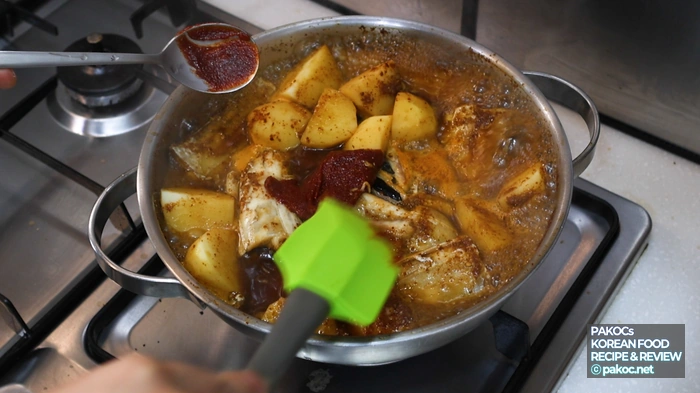
ⓒ
Copyright PAKOC https://pakoc.net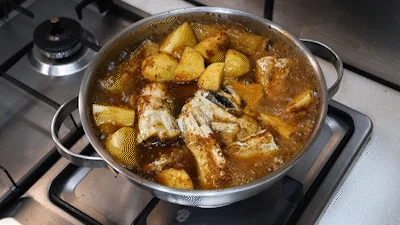
ⓒ
Copyright PAKOC https://pakoc.netFinally, place the green onions and Cheongyang peppers on top, cover, and bring to a boil over medium heat. Alternatively, you can place them on top as a finishing touch.
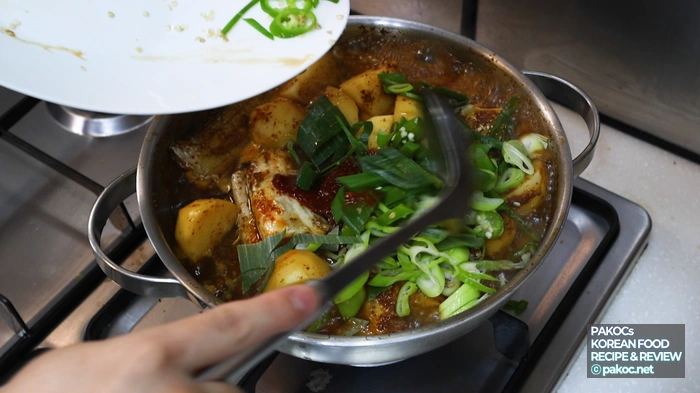
ⓒ
Copyright PAKOC https://pakoc.net
ⓒ
Copyright PAKOC https://pakoc.netMix the green onions and Cheongyang peppers once, transfer to an appropriate dish, and finish by sprinkling roasted sesame seeds or other toppings to taste.
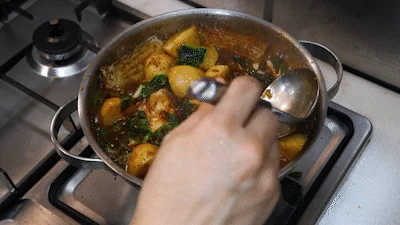
ⓒ
Copyright PAKOC https://pakoc.netGallery Completion
The image slide showcases various scenes, each photo possessing a unique charm. This slide is designed to allow users to feel the story through the photos. Each image captures a specific moment, conveying emotion, and through the slide, you can vividly experience those moments.
Completion
Here is the completed braised hairtail. This dish is styled for the whole family to enjoy, using a sauce that emphasizes the soy sauce flavor rather than being completely spicy. You can make it slightly spicy by adding more red pepper powder and gochujang, or enjoy it as a slightly spicy appetizer by adding plenty of spicy Cheongyang peppers.

ⓒ
Copyright PAKOC https://pakoc.net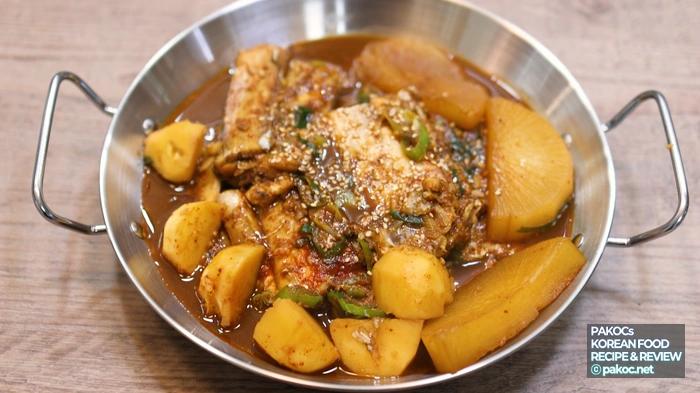
ⓒ
Copyright PAKOC https://pakoc.netBy slightly adjusting the amount of sauce, you can modify it to suit each person’s taste and preference, making it a highly recommended recipe.

ⓒ
Copyright PAKOC https://pakoc.net
ⓒ
Copyright PAKOC https://pakoc.netCooking over low heat for a little longer to allow the seasoning to soak in better is also a good idea! You can pick up a piece of hairtail, pour plenty of broth over it, and enjoy it to your heart’s content.
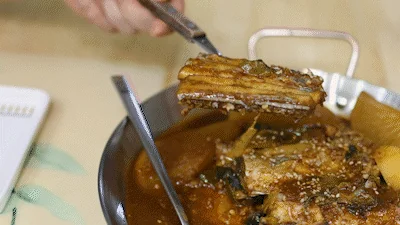
ⓒ
Copyright PAKOC https://pakoc.net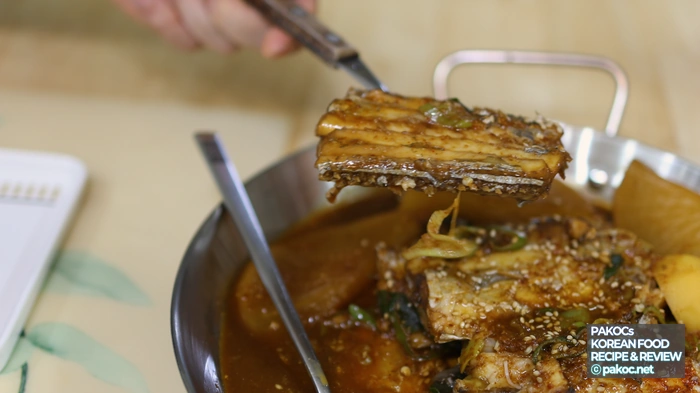
ⓒ
Copyright PAKOC https://pakoc.netAlthough it might be a bit cumbersome to pick out the bones, once you try it with the sauce that suits your taste, you’ll strongly feel that it was worth making. It’s a taste you won’t regret.
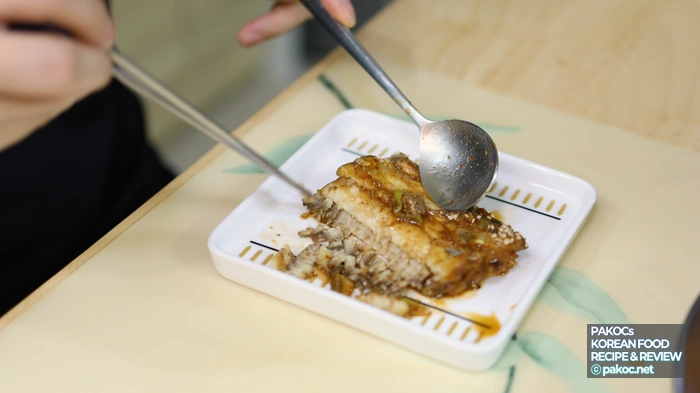
ⓒ
Copyright PAKOC https://pakoc.net
ⓒ
Copyright PAKOC https://pakoc.netimage sources
- 생강가루 요리에 활용법: Copyright PAKOC https://pakoc.net
- 맛술 조리법 소개: Copyright PAKOC https://pakoc.net
- 설탕 양념 조절 팁: Copyright PAKOC https://pakoc.net
- 올리고당 요리 사용법: Copyright PAKOC https://pakoc.net
- 후추가루 양념 사용: Copyright PAKOC https://pakoc.net
- 미원 조미료 활용법: Copyright PAKOC https://pakoc.net
- 요리수 양념 준비: Copyright PAKOC https://pakoc.net
- 고추장 조리 방법 팁: Copyright PAKOC https://pakoc.net
- 무 바닥 깔기 방법: Copyright PAKOC https://pakoc.net
- 조림 냄비 준비 과정: Copyright PAKOC https://pakoc.net
- 비린내 제거 효과 소주: Copyright PAKOC https://pakoc.net
- 맛있는 갈치조림 완성 사진: Copyright PAKOC https://pakoc.net
- 전통 한식 갈치조림 레시피: Copyright PAKOC https://pakoc.net
- 간단한 한식 조리법 소개: Copyright PAKOC https://pakoc.net
- 갈치 조리 비법 소개: Copyright PAKOC https://pakoc.net
- 비린내 제거 비법 소개: Copyright PAKOC https://pakoc.net
- 재료 손질 과정 사진: Copyright PAKOC https://pakoc.net
- 갈치조림 맛 비결 소개: Copyright PAKOC https://pakoc.net
- 갈치조림 집밥 요리 레시피: Copyright PAKOC https://pakoc.net
- 한식 간단 요리 추천: Copyright PAKOC https://pakoc.net
- 갈치조림 조리 과정 사진: Copyright PAKOC https://pakoc.net
- 간단한 갈치 조리 방법: Copyright PAKOC https://pakoc.net
- 마트에서 구매한 손질 갈치: Copyright PAKOC https://pakoc.net
- 소주 비린내 제거 효과: Copyright PAKOC https://pakoc.net
- 갈치 비늘 제거 과정: Copyright PAKOC https://pakoc.net
- 무 조리 과정 사진: Copyright PAKOC https://pakoc.net
- 무 썰기 방법 소개: Copyright PAKOC https://pakoc.net
- 감자 조리 과정 사진: Copyright PAKOC https://pakoc.net
- 갈치 조리 재료 사진: Copyright PAKOC https://pakoc.net
- 간단한 조림 요리 소개: Copyright PAKOC https://pakoc.net
- 대파 어슷 썰기 준비: Copyright PAKOC https://pakoc.net
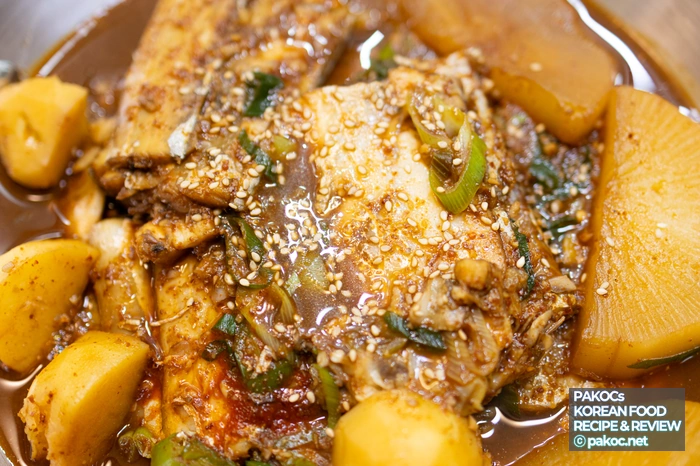
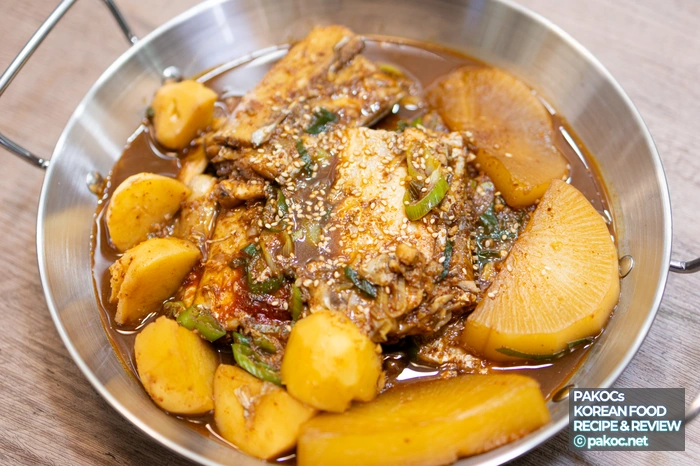
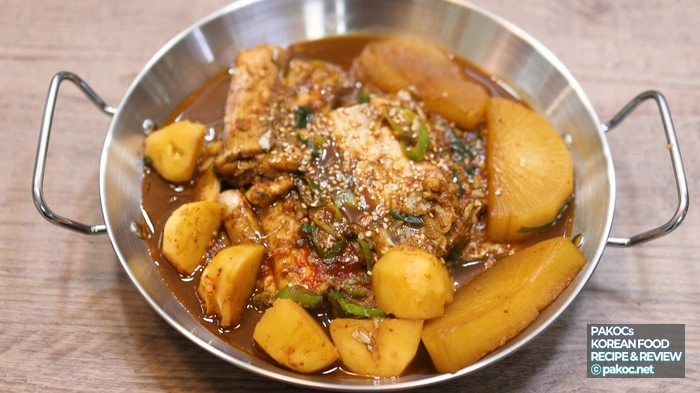
![[Korean Food Recipe] Boneless Gamjatang 집에서 간단하게 만드는 순살 감자탕 소개](https://pakoc.net/wp-content/uploads/2025/08/1_집에서-간단하게-만드는-순살-감자탕-소개.webp)
![[Korean Cuisine Recipe] Savory and Refreshing Yukgaejang 계란 넣기 조리 과정](https://pakoc.net/wp-content/uploads/2025/09/12_계란-넣기-조리-과정-1.webp)
![[Korean Food Recipe] Stir-fried Pork Belly with Kimchi 술안주 저녁메뉴 적합한 돼지삼겹살 김치 두루치기 레시피](https://pakoc.net/wp-content/uploads/2025/08/1_술안주-저녁메뉴-적합한-돼지삼겹살-김치-두루치기-레시피.webp)
![[Korean Food Recipe] Grilled Pork Neck with Doenjang Seasoning 된장 돼지목살 구이 비주얼](https://pakoc.net/wp-content/uploads/2025/10/39_된장-돼지목살-구이-비주얼-2.webp)